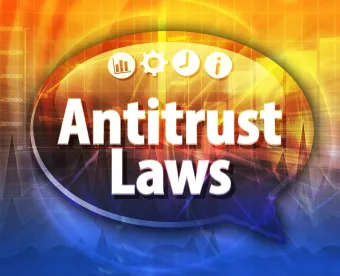“Run a Google search for the phrase ‘minimum advertised price policy’ and you will find hundreds of policies, posted on a variety of manufacturers’ websites. Interest in minimum advertised price (‘MAP’) policies has skyrocketed in recent years.” That is what one of my colleagues wrote in a prescient article in 2013.[i] Since 2013, the interest in MAP policies has exploded. But much of the online guidance regarding MAP policies is misguided and clearly has not been crafted or vetted by antitrust counsel. Manufacturers should proceed with caution and consult with antitrust counsel before adopting a MAP policy.
-
What is a MAP Policy?
MAP policies impose restrictions on the price at which a product or service may be advertised without restricting the actual sales price. In the context of print advertising, MAP policies usually concern only off-site advertising, such as in flyers or brochures. They do not restrict the in-store advertising or sales price offered at the retailer’s “brick and mortar” locations. In the context of internet advertising, MAP policies often concern pricing advertised by an internet retailer on its website. But with internet advertising, the distinction between an advertised price and a sales price is often blurry and requires special attention.
-
What has been driving all the recent interest in MAP?
The e-commerce boom has been one key driver. Although e-commerce has been a financial boon for some by allowing products to reach broader audiences and conveniently connecting consumers to highly discounted and diversified products, other manufacturers are concerned that they are losing control over their brands and the advertising of their products. Once premium branded products might be discounted to the point of being considered cheap. As margins are squeezed, service may suffer and consumers ultimately lose out.
This phenomenon, and how to address it, has attracted massive recent attention, including from the popular press. In 2017, the Wall Street Journal published an article headlined, Brands Strike Back: Seven Strategies to Loosen Amazon’s Grip, reporting that a growing number of brands are pushing back on large online retailers by adopting MAP policies.[ii] The article reported that instituting MAP policies can be effective in decreasing online discounting. A recent Forbes article similarly recommended that manufacturers adopt MAP policies in response to the emergence of e-commerce sites.[iii]
-
Popular Misconceptions About MAP.
Public interest in MAP has been great for drawing attention to the usefulness of MAP policies in addressing brand dilution. But much of the popular discourse about MAP fails to account for the critical legal considerations attendant to adopting and enforcing a MAP policy, and would steer the unwary into legally risky territory. For example, a sampling of articles online—which will go unattributed—offer the following characterizations in promoting MAP policies:
-
A “MAP policy is an agreement between manufacturers and distributors or retailers”;
-
In a MAP policy, “authorized sellers agree to the policy and in return, the brand agrees to enforce their pricing”;
-
To prevent “margin erosion,” “manufacturers and retailers work together to set a minimum advertised price”;
-
MAP should be “enforced by both” the manufacturer and reseller; and
-
Brands should “control sellers” through “enforceable agreements.”
These suggestions to implement MAP through an “agreement” or in “cooperation” with resellers, and to use MAP to enforce product pricing, may have intuitive appeal. And in fact, several MAP templates available online are styled as “agreements” between the manufacturer and reseller. But be warned—these suggestions, if carried out, could pose significant antitrust risk that could subject companies to serious and expensive liability. The next section explains why.
-
Quick Antitrust Legal Guide to MAP.
When most people think of illegal antitrust conspiracies, they think of agreements among competitors to fix prices or restrict competition, which are per se illegal. But in general, manufacturers also may not require their resellers—either distributors or retailers—to resell at (or above) a set price. This is known as minimum resale price maintenance (“RPM”) and it is also per se illegal under antitrust laws in several states.
Although RPM may be per se illegal under certain state laws, MAP policies are generally analyzed under a more lenient legal framework called the “rule of reason.” But a MAP policy must be crafted with care to avoid being treated as RPM. For example, agreements with resellers concerning the minimum advertised price may be viewed, depending on the circumstances, as actually having the effect of setting the minimum sales price, converting the MAP policy into RPM. A MAP policy also must be adopted free from any agreement with a manufacturer’s horizontal competitors, which could be found to be an unlawful horizontal conspiracy. In one prominent example, the Federal Trade Commission (“FTC”) brought an enforcement action against five major competing compact disk (“CD”) distributors challenging their MAP policies as violating federal antitrust laws.[iv] All five major CD distributors had adopted MAP policies around the same time, allegedly at the urging of retailers, and the policies each prohibited all advertising below a certain price, including in-store advertising. The FTC viewed the policies under those circumstances as horizontal agreements among the distributors, and thus per se illegal.
-
Practical Antitrust Pointers for MAP.
Several guiding principles can help minimize antitrust risk in adopting a MAP policy:
-
Advertising Only. A retailer should remain free to sell a product at any price, so that the restriction on advertising is deemed to be a non-price restraint. In the context of online sales, adhering to this principle can require special care, as some might try to argue that there is little distinction between an advertised price and a sales price. MAP policies that concern internet advertising thus often include provisions that allow internet retailers to communicate an actual sales price in a different manner—such as “Call for Pricing” or “Add to Cart to See Price.”
-
No Agreement. A MAP policy should be drafted as a unilateral policy—i.e., a policy that the manufacturer creates on its own (in consultation with antitrust counsel), without input from or agreement with its own competitors or with its downstream resellers. The policy should expressly state that it is a unilateral policy that does not constitute an agreement.
-
Broad Application. Policies that apply to all off-site advertising, no matter the form, are more likely to be upheld than policies that are specifically directed at internet retailers.
-
Clarity. A MAP policy should be user-friendly and easy to understand. One best practice is to include a Frequently Asked Questions guide to clarify how the policy works.
Antitrust risk must be kept in mind not just when a MAP policy is created, but throughout its implementation and enforcement. The manner in which a MAP policy is enforced could risk converting the unilateral policy into conduct that could be viewed as a tacit agreement, even if no written agreement is ever signed. For example, enlisting or “working with” resellers to enforce the policy, as suggested by articles online, could be viewed as evidence that a manufacturer is coordinating with resellers as part of an overall agreement. Working with competitors to coordinate strategies for MAP enforcement would also pose significant legal risk. For that reason, manufacturers that are adopting MAP policies should resist communications with resellers or competitors about MAP and continue to work with antitrust counsel through implementation and enforcement.
To be sure, some may believe that coordination, for example, between manufacturers and retailers, is helpful in stamping out e-commerce discounting. But even if such coordination between manufacturers and retailers could be effective in addressing such discounting, it carries significant legal risks. And potentially risky agreements with resellers are not a manufacturer’s only option in addressing how its products are advertised in e-commerce. Other tools are also available and can be adopted in conjunction with MAP and other policies. As just one example, a unilateral distribution policy, in which a manufacturer unilaterally suspends resellers that sell through unauthorized e-commerce sites, can be a powerful complement to a MAP policy. It also may present a more direct way to address the e-commerce channels through which goods are (or are not) sold. Because such policies do not involve prices, if appropriately created and implemented, U.S. courts are likely to also assess them under the lenient “rule of reason.” It is therefore unsurprising that such policies are gaining in popularity. One recent study surveying over 1,000 European retailers found that policies precluding or limiting e-commerce sales are widely in place with approximately 18% of respondents reporting that manufacturers limit their ability to sell through online marketplaces or platforms and 11% reporting that manufacturers restrict their online sales to their own website.[v]
Ultimately, addressing brand dilution is critical in the e-commerce age. It is also highly fact specific and typically requires custom solutions tailored to a company’s commercial and legal objectives. Adopting an “off the rack” MAP policy and simply hoping for the best is unwise and could lead to expensive litigation or, worse yet, liability and costly penalties. But antitrust lawyers are here to help companies navigate the legal landscape to come up with commonsense solutions that work while minimizing legal risk.
[i] Erika L. Amarante, A Roadmap to Minimum Advertised Price Policies, 16 The Franchise Lawyer 4 (2013), https://www.wiggin.com/erika-l-amarante/publications/a-roadmap-to-minimum-advertised-price-policies/.
[ii] Ruth Simon, Brands Strike Back: Seven Strategies to Loosen Amazon’s Grip, Wall St. J., (Aug. 7, 2017), https://www.wsj.com/articles/brands-strike-back-seven-strategies-to-loosen-amazons-grip-1502103602.
[iii] Danae Vara Borrell, Why Manufacturers Can’t Afford to Ignore Minimum Advertised Price Policies, Forbes Tech. Council (Oct. 17, 2018), https://www.forbes.com/sites/forbestechcouncil/2018/10/17/why-manufacturers-cant-afford-to-ignore-minimum-advertised-price-policies/#167f8d5417ec.
[iv] See In re Sony Entertainment, Inc., No. C-3971, 2000 WL 1257796 (F.T.C. Aug. 30, 2000).
[v] See European Commission, Final Report on the Ecommerce Sector Inquiry, staff working document paragraph 461, http://ec.europa.eu/competition/antitrust/sector_inquiry_swd_en.pdf.





 />i
/>i

